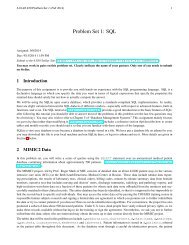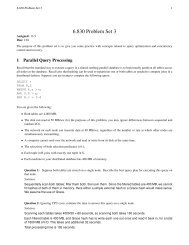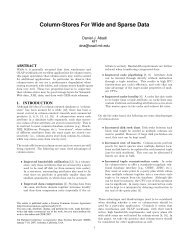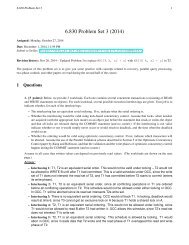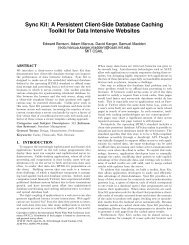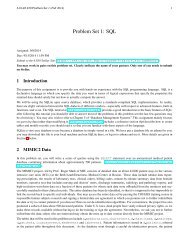H-Store: A High-Performance, Distributed Main ... - Brown University
H-Store: A High-Performance, Distributed Main ... - Brown University
H-Store: A High-Performance, Distributed Main ... - Brown University
Create successful ePaper yourself
Turn your PDF publications into a flip-book with our unique Google optimized e-Paper software.
H-<strong>Store</strong>: A <strong>High</strong>-<strong>Performance</strong>, <strong>Distributed</strong> <strong>Main</strong> Memory<br />
Transaction Processing System<br />
Robert Kallman<br />
Hideaki Kimura<br />
Jonathan Natkins<br />
Andrew Pavlo<br />
Alexander Rasin<br />
Stanley Zdonik<br />
<strong>Brown</strong> <strong>University</strong><br />
{rkallman, hkimura,<br />
jnatkins, pavlo, alexr,<br />
sbz}@cs.brown.edu<br />
Evan P. C. Jones<br />
Samuel Madden<br />
Michael Stonebraker<br />
Yang Zhang<br />
Massachusetts Institute of<br />
Technology<br />
{evanj, madden,<br />
stonebraker,<br />
yang}@csail.mit.edu<br />
John Hugg<br />
Vertica Inc.<br />
jhugg@vertica.com<br />
Daniel J. Abadi<br />
Yale <strong>University</strong><br />
dna@cs.yale.edu<br />
ABSTRACT<br />
Our previous work has shown that architectural and application<br />
shifts have resulted in modern OLTP databases increasingly<br />
falling short of optimal performance [10]. In particular,<br />
the availability of multiple-cores, the abundance of<br />
main memory, the lack of user stalls, and the dominant use<br />
of stored procedures are factors that portend a clean-slate<br />
redesign of RDBMSs. This previous work showed that such<br />
a redesign has the potential to outperform legacy OLTP<br />
databases by a significant factor. These results, however,<br />
were obtained using a bare-bones prototype that was developed<br />
just to demonstrate the potential of such a system. We<br />
have since set out to design a more complete execution platform,<br />
and to implement some of the ideas presented in the<br />
original paper. Our demonstration presented here provides<br />
insight on the development of a distributed main memory<br />
OLTP database and allows for the further study of the challenges<br />
inherent in this operating environment.<br />
1. INTRODUCTION<br />
The use of specialized data engines has been shown to<br />
outperform traditional or “one size fits all” database systems<br />
[8, 9]. Many of these traditional systems use a myriad<br />
of architectural components inherited from the original System<br />
R database, regardless if the target application domain<br />
actually needs such unwieldy techniques [1]. For example,<br />
the workloads for on-line transaction processing (OLTP)<br />
systems have particular properties, such as repetitive and<br />
short-lived transaction executions, that are hindered by the<br />
I/O performance of legacy RDBMS platforms. One obvious<br />
strategy to mitigate this problem is to scale a system horizontally<br />
by partitioning both the data and processing re-<br />
Permission to copy without fee all or part of this material is granted provided<br />
that the copies are not made or distributed for direct commercial advantage,<br />
the VLDB copyright notice and the title of the publication and its date appear,<br />
and notice is given that copying is by permission of the Very Large Data<br />
Base Endowment. To copy otherwise, or to republish, to post on servers<br />
or to redistribute to lists, requires a fee and/or special permission from the<br />
publisher, ACM.<br />
VLDB ‘08, August 24-30, 2008, Auckland, New Zealand<br />
Copyright 2008 VLDB Endowment, ACM 000-0-00000-000-0/00/00.<br />
sponsibilities across multiple shared-nothing machines. Although<br />
some RDBMS platforms now provide support for<br />
this paradigm in their execution framework, research shows<br />
that building a new OLTP system that is optimized from<br />
its inception for a distributed environment is advantageous<br />
over retrofitting an existing RDBMS [2].<br />
Using a disk-oriented RDBMS is another key bottleneck<br />
in OLTP databases. All but the very largest OLTP applications<br />
are able to fit their entire data set into the memory of<br />
a modern shared-nothing cluster of server machines. Therefore,<br />
disk-oriented storage and indexing structures are unnecessary<br />
when the entire database is able to reside strictly<br />
in memory. There are some main memory database systems<br />
available today, but again many of these systems inherit the<br />
architectural baggage of System R [6]. Other distributed<br />
main memory databases have also focused on the migration<br />
of legacy architectural features to this environment [4].<br />
Our research is focused on developing H-<strong>Store</strong>, a nextgeneration<br />
OLTP system that operates on a distributed cluster<br />
of shared-nothing machines where the data resides entirely<br />
in main memory. The system model is based on the<br />
coordination of multiple single-threaded engines to provide<br />
more efficient execution of OLTP transactions. An earlier<br />
prototype of the H-<strong>Store</strong> system was shown to significantly<br />
outperform a traditional, disk-based RDBMS installation<br />
using a well-known OLTP benchmark [10, 11]. The results<br />
from this previous work demonstrate that our ideas have<br />
merit; we expand on this work and in this paper we present<br />
a more full-featured version of the system that is able to<br />
execute across multiple machines within a local area cluster.<br />
With this new system, we are investigating interesting<br />
aspects of this operating environment, including how to exploit<br />
non-trivial properties of transactions.<br />
We begin in Section 2 by first providing an overview of<br />
the internals of the H-<strong>Store</strong> system. The justification for<br />
many of the design decisions for H-<strong>Store</strong> is found in earlier<br />
work [10]. In Section 3 we then expand our previous<br />
discussion on the kinds of transactions that are found in<br />
OLTP systems and the desirable properties of an H-<strong>Store</strong><br />
database design. We conclude the paper in Section 4 by<br />
describing the demonstration system that we developed to<br />
explore these properties further and observe the execution<br />
behavior of our system.
Figure 1: H-<strong>Store</strong> system architecture.<br />
2. SYSTEM OVERVIEW<br />
The H-<strong>Store</strong> system is a highly distributed, row-storebased<br />
relational database that runs on a cluster on sharednothing,<br />
main memory executor nodes.<br />
We define a single H-<strong>Store</strong> instance as a cluster of two<br />
or more computational nodes deployed within the same administrative<br />
domain. A node is a single physical computer<br />
system that hosts one or more sites. A site is the basic operational<br />
entity in the system; it is a single-threaded daemon<br />
that an external OLTP application connects to in order to<br />
execute a transaction. We assume that the typical H-<strong>Store</strong><br />
node has multiple processors and that each site is assigned<br />
to execute on exactly one processor core on a node. Each<br />
site is independent from all other sites, and thus does not<br />
share any data structures or memory with collocated sites<br />
running on the same machine.<br />
Every relation in the database is divided into one or more<br />
partitions. A partition is replicated and hosted on a multiple<br />
sites, forming a replica set.<br />
OLTP applications make calls to the H-<strong>Store</strong> system to<br />
repeatedly execute pre-defined stored procedures. Each procedure<br />
is identified by a unique name and consists of structured<br />
control code intermixed with parameterized SQL commands.<br />
An instance of a store procedure initiated by an<br />
OLTP application is called a transaction.<br />
Using these definitions, we now describe the deployment<br />
and execution schemes of the H-<strong>Store</strong> system (see Figure 1).<br />
2.1 System Deployment<br />
H-<strong>Store</strong> provides an administrator with a cluster deployment<br />
framework that takes as input a set of stored procedures,<br />
a database schema, a sample workload, and a set of<br />
available sites in the cluster. The framework outputs a list<br />
of unique invocation handlers that are used to reference the<br />
procedures at runtime. It is possible to introduce new procedures<br />
into the system after the cluster is deployed; this,<br />
however, results in poorer performance as the database’s<br />
physical design will not be optimized for procedures that<br />
are not known at deployment (see Section 3.2).<br />
Internally the deployment framework generates a set of<br />
compiled stored procedures and a physical database layout<br />
used to instantiate a new H-<strong>Store</strong> cluster. We currently assume<br />
that the administrator provides the framework with a<br />
pre-planned database layout. Future versions of the framework<br />
will include an automatic database designer that generates<br />
an optimized layout using strategic horizontal partitioning,<br />
replication locations, and indexed fields.<br />
A compiled stored procedure in the system is comprised<br />
of multiple distributed skeleton plans, one for each query<br />
in the procedure. Each plan’s sub-operations are not specific<br />
to database’s distributed layout, but are optimized using<br />
common techniques found in non-distributed databases.<br />
Once this first optimization phase is complete, the compiled<br />
procedures are transmitted to each site in the local cluster.<br />
At runtime, the query planner on each site converts skeleton<br />
plans for the queries into multi-site, distributed query plans.<br />
This two-phase optimization approach is similar to strategies<br />
used in previous systems [3]. Our optimizer uses a preliminary<br />
cost model based on the number of network communications<br />
that are needed to process the request. This<br />
has proven to be sufficient in our initial tests as transaction<br />
throughput is not affected by disk access.<br />
2.2 Runtime Model<br />
At execution time, the client OLTP application requests<br />
a new transaction using the stored procedure handlers generated<br />
during deployment process. If a transaction requires<br />
parameter values as input, the client must also pass these to<br />
the system along with the request. We assume for now that<br />
all sites are trusted and reside within the same administrative<br />
domain, and thus we trust any network communication<br />
that the system receives.<br />
Any site in an H-<strong>Store</strong> cluster is able to execute any OLTP<br />
application request, regardless of whether the data needed<br />
by a particular transaction is located on that site. Unless all<br />
of the queries’ parameter values in a transaction are known<br />
at execution time, we use a lazy-planning strategy for creating<br />
optimized distributed execution plans. If all of the<br />
parameter values are known in the beginning, then we perform<br />
additional optimizations based on certain transaction<br />
properties (see Section 3.1).<br />
When a running transaction executes a SQL command,<br />
it makes an internal request through an H-<strong>Store</strong> API. At<br />
this point, all of the parameter values for that query are<br />
known by the system, and thus the plan is annotated with<br />
the locations of the target sites for each query sub-operation.<br />
The updated plan is then passed to a transaction manager<br />
that is responsible for coordinating access with the other<br />
sites. The manager transmits plan fragments to the appropriate<br />
site over sockets and the intermediate results (if<br />
any) are passed back to the initiating site. H-<strong>Store</strong> uses a<br />
generic distributed transaction framework to ensure serializability.<br />
We are currently comparing protocols that are based<br />
on both optimistic and pessimistic concurrency control [5,<br />
12]. The final results for a query are passed back to the<br />
blocked transaction process, which will abort the transaction,<br />
execute more queries, or commit the transaction and<br />
return results back to the client application.<br />
The data storage backend for H-<strong>Store</strong> is managed by a<br />
single-threaded execution engine that resides underneath the<br />
transaction manager. Each individual site executes an autonomous<br />
instance of the storage engine with a fixed amount<br />
of memory allocated from its host machine. Multi-site nodes<br />
do not share any data structures with collocated sites, and<br />
thus there is no need to use concurrent data structures.<br />
3. DATABASE PROPERTIES<br />
Just as with disk-oriented databases, the performance of<br />
distributed main memory databases is dependent on the<br />
data placement strategies and supporting data structures<br />
of the physical database design. But because OLTP sys-
tems repeatedly execute the same set of transactions, the<br />
design can be optimized to execute just these transactions<br />
while completely ignoring ad hoc queries. H-<strong>Store</strong> supports<br />
the execution of the latter, but it provides no guarantees<br />
that the queries are executed in a timely manner. With this<br />
in mind, in the following section we discuss different classes<br />
of transactions for our system model; these classes have exploitable<br />
properties that enable us to execute them more<br />
efficiently than general transactions. We then describe the<br />
challenges in designing a database for H-<strong>Store</strong> that facilitate<br />
these classes.<br />
3.1 Transaction Classes<br />
We described in our previous paper a set of special case<br />
transaction classes that are found in constrained tree table<br />
schemas for OLTP applications [10]. We now provide a<br />
more concise description of two of these classes and briefly<br />
discuss how H-<strong>Store</strong> generates an optimal execution strategy<br />
for each. Because a query can have unknown parameter<br />
values at deployment, the distributed query planner cannot<br />
always determine the transaction class before execution<br />
time. We plan to investigate the usefulness of probabilistic<br />
optimization techniques that estimate the values of these<br />
parameters and infer the target site using the cardinality of<br />
the columns referenced in the query.<br />
Single-sited Transactions: A transaction is single-sited<br />
if all of the queries contained within it can be executed on<br />
just one computational site in the cluster. Although the<br />
transaction is sent to two or more sites for execution (due<br />
to replicated data), it does not require intermediate results<br />
from any other site. This transaction class is the most desirable<br />
since it does not need to use undo logs, concurrency<br />
control mechanisms, or communication with other sites, beyond<br />
that which is required for replication.<br />
When H-<strong>Store</strong> receives a single-sited transaction request,<br />
the site that receives the request will transfer execution control<br />
along with any compiled plans over to one of the target<br />
sites. This new site begins processing the transaction and<br />
executes the queries at that site instead of the site where the<br />
request was originally made. The overhead from transferring<br />
a request between two sites is offset by the performance<br />
gains made from avoiding cross-site network communication.<br />
One-shot Transactions: A transaction is one-shot if it<br />
cannot execute on a single-site, but each of its individual<br />
queries will execute on just one site (not necessarily all the<br />
same site). Unlike single-sited transactions, we assume that<br />
the outputs of queries in one-shot transactions are not used<br />
as input to subsequent queries in the same transaction. H-<br />
<strong>Store</strong> performs a simple optimization technique if a transaction<br />
is declared one-shot: the request is transferred to the<br />
most accessed site for that transaction instance in the same<br />
manner as is done with single-sited transactions.<br />
3.2 Physical Layout<br />
There are two conflicting goals in any H-<strong>Store</strong> database<br />
design: the ability to execute transactions as quickly as possible<br />
versus the need to maintain system availability. To<br />
achieve the former, a transaction invocation needs to execute<br />
on as few sites as possible, thereby minimizing the amount<br />
of cross-site messaging between transaction managers. Obvious<br />
strategies include replicating frequently accessed or<br />
read-only tables on all sites and collocating tables that are<br />
joined often together on the same site. More complex designs<br />
can involve horizontal partitioning schemes where related<br />
data partitions are collocated together or that partition<br />
tables more than once using multiple attributes. The<br />
problem of choosing a layout scheme becomes exceedingly<br />
difficult when deciding which of these policies should take<br />
precedence and which procedures to optimize over others.<br />
Furthermore, because H-<strong>Store</strong> does not keep any data in<br />
non-volatile storage, it must rely on strategic data distribution<br />
schemes in order to maintain high-availability. Previous<br />
literature introduced the concept of k-safety in distributed<br />
database systems, where k is defined as the number of node<br />
failures a database is designed to tolerate [7]. If k is set<br />
too low for an H-<strong>Store</strong> deployment, than a small number of<br />
node failures will render the entire system inoperable. Conversely,<br />
if k is too high, then the nodes may not have enough<br />
memory to store their copies of the data and can reduce the<br />
overall system throughput.<br />
Because we will need to generate intelligent layouts for<br />
arbitrary schemas and workloads, the development of an<br />
automatic database designer is an area of current research.<br />
4. DEMONSTRATION<br />
To illustrate how the database properties discussed in the<br />
previous section affects the performance of a distributed<br />
OLTP system, we will demonstrate the H-<strong>Store</strong> system executing<br />
on a cluster. We use the TPC-C benchmark’s set<br />
of transactions, database schema, and pre-generated data<br />
as our target domain [11]. When the demonstration system<br />
is started, the benchmark workload application connects to<br />
each of the sites and begins making transaction execution<br />
requests to the H-<strong>Store</strong> system. The frequency of each transaction<br />
is defined by the benchmark weights, but the distribution<br />
of the requests made to the sites is random. The<br />
demonstration executes in two distinct operational modes:<br />
(1) a pre-generated workload with fixed parameter values or<br />
(2) a randomly generated workload mode with randomized<br />
values. The pre-generated workloads allow the user to directly<br />
compare the performance results of different layout<br />
schemes. The random mode records the workload as it is<br />
generated on-the-fly for future playback. It also allows the<br />
user to modify the workload characteristics, such as the frequency<br />
that a site receives transaction requests.<br />
4.1 Workload Controller<br />
We provide a graphical interface on a separate machine<br />
that allows users to dynamically observe the execution and<br />
performance details of a running H-<strong>Store</strong> system. As shown<br />
in the mock-up in Figure 2, this interface provides a headsup<br />
display on the internal message passing and query plan<br />
execution in the cluster. The user is allowed to throttle<br />
the operating speed of the entire H-<strong>Store</strong> system and to<br />
manually execute a specific stored procedure in isolation.<br />
The workload controller also provides a historical view<br />
of the number of transactions executed per second. This<br />
timeline view shows aggregate statistics for each operation<br />
performed in the system, such as number of rows examined,<br />
total number of network messages, and the size of those<br />
messages. The user switches the scope of this view based<br />
on stored procedure invocation handlers or query operation<br />
types in order to view the performance of the system components.<br />
This enables a direct comparison of different layout
ased on its primary key. Every site is given a unique set of<br />
three partitions per table, thus preventing any pair of two<br />
sites from holding the only copies of a partition.<br />
At any time during workload execution, the user is able<br />
to halt the running system, flush the database, and re-load<br />
a different layout scheme. Every reload of the database is<br />
considered a new workload session, and the system keeps<br />
track of the execution results of each session for later review.<br />
Figure 2: The graphical interface of the H-<strong>Store</strong> controller<br />
allows users to dynamically change properties<br />
of the running sample application and change the<br />
physical layout of the database.<br />
schemes and workload generation parameters.<br />
4.2 Database Layout Loader<br />
The main focus of our demonstration is to show the impact<br />
of differing physical layouts for an H-<strong>Store</strong> database, and<br />
how these layouts affect the execution properties of transactions.<br />
Every site in the demonstration cluster is loaded<br />
with a set of pre-planned database designs that allow users<br />
to observe the implications of various layout schemes. The<br />
quality of a particular database layout is based on the number<br />
of transactions per second that the cluster can execute.<br />
For each of the three attributes listed below, we generate<br />
a separate database design for TPC-C’s nine table schema<br />
using a manual designer tool. These three designs represent<br />
the optimal layout for their corresponding attributes.<br />
We also generate a fourth “control” layout where each table<br />
is replicated in a random manner on two sites. Each<br />
database design only uses a single B-Tree index for each table<br />
based on that table’s primary key and replicated sets<br />
that are sorted on the same column. We ensure that each<br />
database layout has a base failure tolerance of one node (ksafety<br />
= 1). Although placing tables joined by a foreign key<br />
together on the same site improves execution performance,<br />
we ignore this optimization strategy in our demonstration.<br />
Table Replication: Every read-only table is replicated on<br />
all sites. This design highlights the execution speed gained<br />
from avoiding extraneous network communication, thereby<br />
shortening the execution time of transactions.<br />
Data Partitioning: All tables are divided horizontally into<br />
four distinct partitions that are stored on two separate sites.<br />
As opposed to the previous table replication layout scheme,<br />
which promotes shorter transaction execution times, this<br />
layout demonstrates how concurrent transactions execute in<br />
parallel if the data is sufficiently partitioned.<br />
K-Safety: This layout is generated using a horizontal partitioning<br />
scheme with a k-safety factor of two. It is not<br />
possible to replicate all of the tables in the database on any<br />
one site, since the total size of the database is larger than<br />
the available memory on a node. We therefore use a replication<br />
factor of two and partition each table into equal parts<br />
5. REFERENCES<br />
[1] M. M. Astrahan, M. W. Blasgen, D. D. Chamberlin,<br />
K. P. Eswaran, J. N. Gray, P. P. Griffiths, W. F. King,<br />
R. A. Lorie, P. R. McJones, J. W. Mehl, G. R.<br />
Putzolu, I. L. Traiger, B. W. Wade, and V. Watson.<br />
System R: relational approach to database<br />
management. ACM Trans. Database Syst.,<br />
1(2):97–137, 1976.<br />
[2] D. J. DeWitt, R. H. Gerber, G. Graefe, M. L.<br />
Heytens, K. B. Kumar, and M. Muralikrishna.<br />
Gamma - a high performance dataflow database<br />
machine. In VLDB ’86, pages 228–237, 1986.<br />
[3] W. Hong and M. Stonebraker. Optimization of<br />
parallel query execution plans in xprs. In PDIS ’91,<br />
pages 218–225, 1991.<br />
[4] H. V. Jagadish, D. F. Lieuwen, R. Rastogi,<br />
A. Silberschatz, and S. Sudarshan. Dali: A high<br />
performance main memory storage manager. In VLDB<br />
’94, pages 48–59, 1994.<br />
[5] I. Lee and H. Y. Yeom. A single phase distributed<br />
commit protocol for main memory database systems.<br />
In IPDPS ’02, page 44, 2002.<br />
[6] A.-P. Liedes and A. Wolski. SIREN: A<br />
memory-conserving, snapshot-consistent checkpoint<br />
algorithm for in-memory databases. In ICDE ’06,<br />
page 99, 2006.<br />
[7] M. Stonebraker, D. J. Abadi, A. Batkin, X. Chen,<br />
M. Cherniack, M. Ferreira, E. Lau, A. Lin,<br />
S. Madden, E. O’Neil, P. O’Neil, A. Rasin, N. Tran,<br />
and S. Zdonik. C-<strong>Store</strong>: A column-oriented dbms. In<br />
VLDB ’05, pages 553–564, 2005.<br />
[8] M. Stonebraker, C. Bear, U. Cetintemel,<br />
M. Cherniack, T. Ge, N. Hachem, S. Harizopoulos,<br />
J. Lifter, J. Rogers, and S. B. Zdonik. One size fits<br />
all part 2: Benchmarking studies. In CIDR ’07,<br />
pages 173–184, 2007.<br />
[9] M. Stonebraker and U. Cetintemel. ”one size fits all”:<br />
An idea whose time has come and gone. In ICDE ’05,<br />
pages 2–11, 2005.<br />
[10] M. Stonebraker, S. Madden, D. J. Abadi,<br />
S. Harizopoulos, N. Hachem, and P. Helland. The end<br />
of an architectural era: (it’s time for a complete<br />
rewrite). In VLDB ’07, pages 1150–1160, 2007.<br />
[11] The Transaction Processing Council. TPC-C<br />
Benchmark (Revision 5.9.0).<br />
http://www.tpc.org/tpcc/spec/tpcc current.pdf,<br />
June 2007.<br />
[12] A. Whitney, D. Shasha, and S. Apter. <strong>High</strong> volume<br />
transaction processing without concurrency control,<br />
two phase commit, sql or c. In Int. Workshop on <strong>High</strong><br />
<strong>Performance</strong> Transaction Systems.



